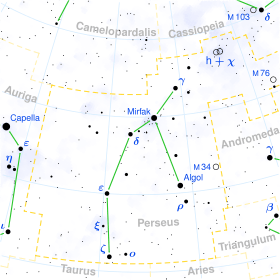31 Persei
31 Persei is a single[13] star in the northern constellation of Perseus. It is visible to the naked eye as a dim, blue-white hued point of light with an apparent visual magnitude of 5.05.[2] This star is located around 172 parsecs (560 ly) away from the Sun,[14] and it is drifting closer with a radial velocity of −1.6 km/s.[5] It is a likely member of the Alpha Persei Cluster.[15]
| Observation data Epoch J2000 Equinox J2000 | |
|---|---|
| Constellation | Perseus |
| Right ascension | 03h 19m 07.63796s[1] |
| Declination | 50° 05′ 41.8724″[1] |
| Apparent magnitude (V) | 5.05[2] |
| Characteristics | |
| Spectral type | B5V[3] |
| U−B color index | −0.53[4] |
| B−V color index | −0.06[4] |
| Astrometry | |
| Radial velocity (Rv) | −1.60[5] km/s |
| Proper motion (μ) | RA: +23.580[1] mas/yr Dec.: −23.322[1] mas/yr |
| Parallax (π) | 5.8399 ± 0.1792[1] mas |
| Distance | 560 ± 20 ly (171 ± 5 pc) |
| Absolute magnitude (MV) | −1.44[6] |
| Details | |
| Mass | 4.647[7] M☉ |
| Radius | 3.4[8] R☉ |
| Luminosity | 950[6] L☉ |
| Temperature | 15,301[6] K |
| Metallicity [Fe/H] | 0.00[9] dex |
| Rotational velocity (v sin i) | 260[10] km/s |
| Age | 234[11] Myr |
| Other designations | |
| Database references | |
| SIMBAD | data |
This object is a B-type main-sequence star with a stellar classification of B5V,[3] a massive star that is currently generating energy through hydrogen fusion at its core. It is around 234[9] million years old and spinning rapidly with a projected rotational velocity of 260 km/s.[10] The star has 4.6[7] times the mass of the Sun and about 3.4[8] times the Sun's radius. It is radiating 950[6] times the luminosity of the Sun from its photosphere at an effective temperature of 15,301 K.[6]
References
- Brown, A. G. A.; et al. (Gaia collaboration) (August 2018). "Gaia Data Release 2: Summary of the contents and survey properties". Astronomy & Astrophysics. 616. A1. arXiv:1804.09365. Bibcode:2018A&A...616A...1G. doi:10.1051/0004-6361/201833051. Gaia DR2 record for this source at VizieR.
- Anderson, E.; Francis, Ch. (2012). "XHIP: An extended hipparcos compilation". Astronomy Letters. 38 (5): 331. arXiv:1108.4971. Bibcode:2012AstL...38..331A. doi:10.1134/S1063773712050015. Vizier catalog entry
- Hoffleit, D.; Warren, W. H. (1995). "VizieR Online Data Catalog: Bright Star Catalogue, 5th Revised Ed. (Hoffleit+, 1991)". VizieR On-line Data Catalog: V/50. Originally Published in: 1964BS....C......0H. 5050. Bibcode:1995yCat.5050....0H.
- Mallama, A. (2014). "Sloan Magnitudes for the Brightest Stars". The Journal of the American Association of Variable Star Observers. 42: 443. Bibcode:2014JAVSO..42..443M.Vizier catalog entry
- Gontcharov, G. A. (2006). "Pulkovo Compilation of Radial Velocities for 35 495 Hipparcos stars in a common system". Astronomy Letters. 32 (11): 759. arXiv:1606.08053. Bibcode:2006AstL...32..759G. doi:10.1134/S1063773706110065.
- Silaj, J.; Landstreet, J. D. (2014). "Accurate age determinations of several nearby open clusters containing magnetic Ap stars". Astronomy & Astrophysics. 566: A132. arXiv:1407.4531. Bibcode:2014A&A...566A.132S. doi:10.1051/0004-6361/201321468.
- Sheikhi, Najmeh; et al. (March 2016). "The binary fraction and mass segregation in Alpha Persei open cluster". Monthly Notices of the Royal Astronomical Society. 457 (1): 1028–1036. arXiv:1601.02186. Bibcode:2016MNRAS.457.1028S. doi:10.1093/mnras/stw059.
- Pasinetti Fracassini, L. E.; et al. (February 2001). "Catalogue of Apparent Diameters and Absolute Radii of Stars (CADARS)". Astronomy and Astrophysics (Third ed.). 367 (2): 521–524. arXiv:astro-ph/0012289. Bibcode:2001A&A...367..521P. doi:10.1051/0004-6361:20000451.
- Gontcharov, G. A. (2012). "Dependence of kinematics on the age of stars in the solar neighborhood". Astronomy Letters. 38 (12): 771. arXiv:1606.08814. Bibcode:2012AstL...38..771G. doi:10.1134/S1063773712120031. Vizier catalog entry
- Abt, Helmut A.; et al. (2002). "Rotational Velocities of B Stars". The Astrophysical Journal. 573: 359. Bibcode:2002ApJ...573..359A. doi:10.1086/340590.
- Gontcharov, G. A. (November 2012). "Spatial distribution and kinematics of OB stars". Astronomy Letters. 38 (11): 694–706. arXiv:1606.09028. Bibcode:2012AstL...38..694G. doi:10.1134/S1063773712110035.
- "31 Per". SIMBAD. Centre de données astronomiques de Strasbourg. Retrieved 2019-07-13.
- Eggleton, P. P.; Tokovinin, A. A. (September 2008). "A catalogue of multiplicity among bright stellar systems". Monthly Notices of the Royal Astronomical Society. 389 (2): 869–879. arXiv:0806.2878. Bibcode:2008MNRAS.389..869E. doi:10.1111/j.1365-2966.2008.13596.x.
- Van Leeuwen, F. (2007). "Validation of the new Hipparcos reduction". Astronomy and Astrophysics. 474 (2): 653. arXiv:0708.1752. Bibcode:2007A&A...474..653V. doi:10.1051/0004-6361:20078357. Vizier catalog entry
- Zuckerman, B.; et al. (June 2012). "Stellar Membership and Dusty Debris Disks in the α Persei Cluster". The Astrophysical Journal. 752 (1): 12. arXiv:1204.3950. Bibcode:2012ApJ...752...58Z. doi:10.1088/0004-637X/752/1/58. 58.
